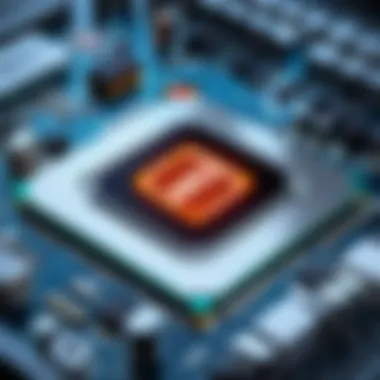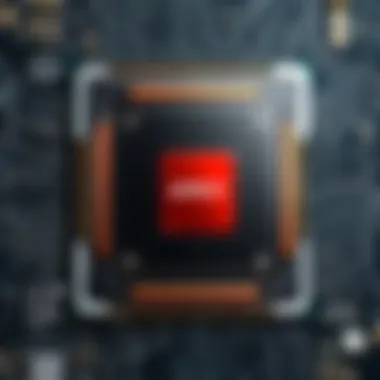A Comprehensive Analysis of AMD 5000 CPUs Performance


Intro
The AMD 5000 series processors have significantly impacted the CPU market since their release. These processors are a testament to technological advancements that AMD has achieved in recent years. Understanding the nuances of these CPUs is crucial for both tech enthusiasts and professionals. This article will provide an extensive examination of the performance metrics, architectural changes, and market implications of the AMD 5000 series.
By analyzing essential benchmarks and user experiences, we will highlight the distinctions that make these processors stand out in a crowded market dominated mostly by Intel. The architectural features of these CPUs possess not only theoretical appeal but also practical advantages that resonate well with both gamers and productivity users alike.
In addition, let's explore how AMD's innovations have led to new possibilities in gaming, streaming, and general work tasks. The relevance of this topic extends beyond specifications; it touches on genuine user experiences that shape the perception of AMD's capabilities in real-world applications. Let's delve deeper into the AMD 5000 series to unveil what they bring to the table.
Prologue to AMD CPUs
The AMD 5000 series has emerged as a pivotal development in the landscape of computer processors, reflecting significant advancements in both technology and performance. Understanding this series is crucial for anyone interested in modern computing, whether for gaming, professional work, or general research.
The AMD 5000 CPUs have been designed to address the demands of today’s users. They offer exceptional performance, especially in multithreaded applications and gaming scenarios, which are paramount for tech enthusiasts looking for the best experience. The series has enabled AMD to reclaim and strengthen its position in a market that was once dominated by a single competitor.
Overview of AMD's CPU Evolution
To appreciate the merit of the AMD 5000 series, one must consider AMD's trajectory in CPU development. AMD started gaining traction with the introduction of the Athlon series back in the late 1990s. Over the years, innovations like the64-bit capabilities in the Opteron and Athlon 64 chips provided a strong foothold in server and consumer markets.
The introduction of the Ryzen series in 2017 marked a new era for AMD, showcasing its ability to compete by offering powerful processors that were economically feasible. Each iteration brought improvements in efficiency, core counts, and overall performance. The 5000 series builds on this foundation by integrating the latest Zen 3 architecture, which is crucial in setting the benchmark for performance. This progressive evolution highlights AMD's commitment to pushing boundaries in processor technology.
Market Position of AMD Series
In the current landscape, the AMD 5000 series holds a strong market position against its closest competitor, Intel. It is critical to note that these processors not only match but often outclass similar offerings from Intel in specific scenarios, particularly in gaming and content creation. Users have shown a growing preference for AMD due to the competitive price-to-performance ratio.
This market shift reflects a broader trend of consumers seeking high-performance options without excessive financial burden. The AMD 5000 series has successfully appealed to a diverse audience, from hardcore gamers to professionals needing reliable performance for demanding tasks.
The AMD 5000 CPUs are not just a product; they represent a strategic pivot in computing, indicating that performance does not have to come at a premium price.
As the AMD 5000 series continues to gain traction, it's important to explore its architectural innovations, performance benchmarks, and how it stands up to competitors. This exploration will offer substantial insights into why these CPUs are becoming a preferred choice in the market.
Architectural Innovations in the AMD Series
Architectural innovations play a crucial role in the performance and efficiency of AMD's 5000 series CPUs. These advancements set the stage for a competitive landscape, particularly when compared to previous models and rival processors. AMD’s engineering decisions have yielded significant implications for both gaming and productivity applications. The Zen 3 architecture serves as the cornerstone for these processors, enabling enhancements in processing power, energy efficiency, and overall user experience.
The advantages of these architectural improvements extend to several aspects. Better core design, increased clock speeds, and an enhanced instruction per clock (IPC) performance deliver a processing experience that meets the demands of today’s software and applications. Efforts to minimize power consumption also ensure that users gain both efficiency and performance, which is indispensable in modern computing environments.
Zen Architecture Explained
The Zen 3 architecture represents a milestone in AMD's design philosophy. Launched in late 2020, it introduced notable changes over its predecessor, Zen 2. One key feature is the unified core complex, or CCX, which allows all cores to directly access a shared L3 cache. This innovation significantly reduces latency, thereby enhancing overall processing speed when executing tasks that require frequent data access.
AMD incorporated a 7nm manufacturing process in Zen 3. This technology fosters higher transistor density, leading to better performance with lower heat generation. The increased clock speeds allow for higher performance across both single-threaded and multi-threaded applications, making the CPUs competitive in diverse workloads. Both gamers and professionals find substantial improvements in rendering and overall responsiveness, resulting in a smoother experience, whether in gameplay or software applications.
Improvements in Efficiency and Performance


Efficiency is one of the key pillars of the AMD 5000 series. The architectural changes in the Zen 3 design not only improve performance but also optimize power usage. For example, power management technologies have become sophisticated, allowing for dynamic adjustments based on workload demand. This means that during intensive calculations, the CPU can ramp up quickly, yet it reduces power draw when under less stress.
Benchmark tests indicate that AMD 5000 CPUs outperform many of their predecessors in both power efficiency and processing capability.
- Higher clock speeds improve performance metrics across various benchmarks, from gaming scenarios to productivity tasks.
- IPC improvements result in better utilization of available resources, yielding more productive output per watt of power consumed.
In summary, the architectural innovations in the AMD 5000 series CPUs mark a decisive point in AMD's competitive strategy. The introduction of Zen 3 has led to advancements that enhance core performance, efficiency, and user satisfaction, setting a new standard for what processors can achieve.
Performance Benchmarks of AMD CPUs
The performance benchmarks of AMD 5000 CPUs are vital for understanding their capabilities and how they stack up against competing products in the market. With the rise of high-demand applications, especially in gaming and productivity, knowing how these processors perform under various workloads is essential for potential buyers. The benchmarks provide insights into the real-world performance of the CPUs, encompassing various tests that measure frame rates, processing speeds, and multitasking abilities. This section will analyze two significant areas of interest: gaming performance and productivity performance.
Gaming Performance Analysis
Gaming performance is a critical factor for many users selecting AMD 5000 CPUs. The series has demonstrated much strength in handling modern titles at high settings, thanks to its robust architecture and improved core designs. Benchmarks typically focus on key gaming titles such as "Cyberpunk 2077," "Call of Duty: Warzone," and "Assassin's Creed Valhalla," comparing frame rates achieved using different resolutions.
- Frame Rates: Many tests reveal that CPUs within the 5000 series provide excellent frame rates, often exceeding 60 fps at 1440p resolution, showing a solid performance for gamers on high refresh rate monitors.
- Overclocking Capabilities: The 5000 series also allows enthusiasts to push performance beyond typical limits. Users often report substantial gains in frames per second when engaging in overclocking, further emphasizing the power of these processors in gaming.
- Game Compatibility: AMD's Smart Access Memory technology enhances performance by allowing the CPU to utilize GPU memory more efficiently. This synergy improves load times and frame rates in both new and older titles.
"The AMD 5000 series CPUs have shifted the gaming landscape, providing a competitive edge to gamers who prioritize high performance and efficiency."
Productivity and Multithreaded Performance
Aside from gaming, the AMD 5000 series CPUs also shine in productivity tasks. Many users rely on their machines for video editing, 3D rendering, and various other multithreaded applications. Here, the processors demonstrate significant improvements over earlier generations.
- Multithreaded Performance: The architectural design includes increased core counts and improved thread handling. Benchmarks from software such as Blender and Cinebench show that these CPUs perform exceptionally well in multithreaded workloads, often leading to faster rendering times and smoother performance in complex tasks.
- Efficiency: The CPUs display an impressive performance-to-watt ratio, making them not just powerful but also efficient in terms of energy consumption. This factor is particularly appealing for professionals who require systems that can handle intense workloads without incurring high energy costs.
- Real-world Applications: Users engaged in software development, data analysis, and content creation notice significant improvements in compile times and processing tasks. Many reports indicate that performance can be up to 20% faster compared to previous generations, providing tangible benefits in day-to-day use.
Comparison with Competing Processors
Understanding the comparison between AMD’s 5000 series CPUs and their main competitors is essential for anyone looking to invest in a new processor. This section will shed light on the critical aspects of this comparison, focusing on both technical specifications and user feedback. The rivalry between AMD and Intel has shaped the CPU market for years, with each brand striving to push the envelope in performance and efficiency. Here, we explore how AMD's latest CPU offerings stack up against Intel’s most relevant processors in terms of performance metrics, price, and market perception.
Intel vs AMD: A Detailed Comparison
When examining AMD 5000 CPUs, it is vital to look at how they compare to Intel's latest offerings. Intel's Core i9 and i7 series often represent the upper echelons of CPU performance. However, AMD's 5000 series, particularly the Ryzen 9 and Ryzen 7 processors, has introduced compelling competition.
Key differences include:
- Core Count: AMD's 5000 series typically offers higher core counts compared to Intel's equivalents, allowing for better multitasking capabilities and performance in threaded applications.
- Clock Speeds: Intel processors have traditionally excelled in higher boost clock speeds, which can lead to slightly better performance in single-threaded applications. However, AMD 5000 CPUs have made significant gains and now often match or exceed Intel in certain scenarios.
- Thermal Management: The heat generation and thermal performance differ between the two brands. AMD CPUs have shown improvements in thermal efficiency. Therefore, they can reach similar performance levels while utilizing less power.
- Integrated Graphics: Intel still holds the advantage in offering processors with strong integrated graphics performance. AMD's solutions generally require dedicated graphics for optimal performance, particularly in gaming.
Overall, the choice between AMD and Intel largely depends on specific user needs, whether leaning towards gaming, content creation, or general productivity. Users should weigh these aspects based on their use case scenarios.
Analyzing Price-to-Performance Ratios
Another crucial element of the comparison is the price-to-performance ratio of AMD 5000 series CPUs versus Intel processors. Price efficiency is often a deciding factor for buyers, especially gamers and professionals on a budget.
AMD has positioned its 5000 series CPUs as cost-effective alternatives without significantly compromising on performance. For instance, comparing the Ryzen 9 5900X with an Intel Core i9-10900K, users often find that they can achieve similar or better performance with a lower investment in AMD’s offering.


- Value Proposition: With good performance at competitive prices, AMD 5000 CPUs help deliver more cores for the same price as their Intel counterparts, catering to users who need high processing power for several tasks.
- Market Trends: AMD’s rise in market presence due to strong price-to-performance ratios has gained it attention in eSports and gaming communities. Many gamers are now adopting AMD CPUs to maximize budgets while maintaining high performance levels.
- Long-term Investment: Purchasers should also consider the potential longevity of their CPUs. AMD’s architecture has shown a favorable upgrade path, suggesting that future generations will likely still be compatible with existing motherboards, adding further value to initial investments.
"Price-to-performance ratios play a pivotal role in determining the best value for users, making AMD's offerings particularly attractive to a broad audience."
Compatibility and Integration
The Compatibility and Integration of AMD 5000 CPUs is a vital aspect for anyone considering these processors. Choosing a CPU is not just about picking the fastest model available but understanding how well it interacts with other components in a system. This section explores how AMD's 5000 series processors fit into the broader ecosystem of computer hardware, which includes motherboards and RAM.
Motherboard Considerations
When it comes to the AMD 5000 CPUs, selecting the right motherboard can significantly influence performance and efficiency. These processors utilize the AM4 socket, which has been widely adopted across various motherboard models. It's crucial to ensure that the motherboard is compatible with Zen 3 architecture to fully exploit the performance benefits of the 5000 series.
- Chipset Compatibility: Not all motherboards support the latest features. Chipsets like B550 and X570 offer full compatibility with the Ryzen 5000 series, taking advantage of PCIe 4.0 technology for faster data transfer rates.
- BIOS Updates: Many older motherboards may require a BIOS update for proper support. This is an essential step that users should not overlook, as an outdated BIOS can lead to issues related to performance and compatibility.
"An updated BIOS is not just a recommendation; it's a necessity for optimizing performance with new hardware."
- Expansion Slots: Ensure that the motherboard has adequate expansion slots for GPUs and other components, as AMD 5000 series CPUs appeal to gamers and professionals who may wish to upgrade system capabilities.
RAM Compatibility and Optimization
The choice of RAM is also critical when harnessing the full potential of AMD 5000 CPUs. With the support for both DDR4 memory types, it is essential to consider speed, capacity, and overall compatibility.
- Memory Speed: AMD CPUs benefit from faster RAM speeds, particularly 3200 MHz or higher. Faster RAM can yield substantial improvements in certain applications, especially in gaming scenarios where higher frame rates are desired.
- Dual Channel Configuration: For optimal performance, utilizing a dual-channel memory setup is advised. This involves installing two sticks of identical RAM to increase bandwidth and improve responsiveness in various applications.
- Timing and Latency: Besides speed, the timing and latency of RAM can also influence performance. Lower latency numbers usually mean better performance, especially in memory-intensive workloads.
User Experiences and Community Feedback
User experiences and community feedback serve as crucial indicators of a product's real-world performance. AMD users often share insights that transcend mere specifications, bridging the gap between technical prowess and practical application. By examining these perspectives, we gain a deeper understanding of how the AMD 5000 CPUs perform in varied use cases. This aspect is particularly relevant in the current landscape of gaming and productivity where user satisfaction can influence purchasing decisions significantly.
Reviews from Gamers and Enthusiasts
Gamers and tech enthusiasts have been vocal in sharing their experiences with AMD 5000 CPUs. Performance in gaming, often the primary concern, has shown remarkable results across a range of titles. Many users report higher frame rates and smoother gameplay when compared to previous models. Notably, the Zen 3 architecture enables optimizations that enhance gaming efficiency, making these CPUs a favored choice for serious gamers.
Community forums like Reddit have numerous threads dedicated to user experiences regarding specific games, including Call of Duty: Warzone and Cyberpunk 2077. In these discussions, players emphasize:
- Overclocking capabilities: Many gamers appreciate the headroom for tuning performance further without significant stability issues.
- Thermal performance: Enhanced cooling solutions help maintain lower temperatures during prolonged gaming sessions, which is favorably noted by users.
- Price-to-performance ratio: Enthusiasts highlight that AMD's offerings do not just match, but often outperform similarly priced Intel counterparts, creating a strong following.
"I was blown away by the performance of my new Ryzen 7 5800X in Assassin’s Creed Valhalla. Not only were frame rates consistently high, but the gameplay was smoother than anything I'd experienced before."
- Reddit User
Feedback from Professionals and Creatives
Professionals and creatives form another critical segment of AMD's user base. Content creators, graphic designers, and video editors often rely on processing power for tasks that demand high performance. The AMD 5000 series has garnered attention for its ability to handle intensive applications such as Adobe Premiere Pro and Blender.


In professional settings, the following aspects are frequently praised:
- Multithreading efficiency: The high core and thread counts attributed to the AMD 5000 series allow for efficient multitasking and faster rendering times.
- Affinity for software optimization: Many professionals report that leading software products are increasingly optimized for AMD architectures, providing competitive advantages during creative workflows.
- Cost-effectiveness: The pricing of these CPUs allows professionals access to high-end performance without breaking their budgets, making them attractive for startups and freelance creatives.
User feedback is often discussed on platforms like Facebook and tech forums, helping potential buyers make informed choices. The community's consensus highlights that the AMD 5000 CPUs are not just powerful for gaming, but also stand out in professional realms.
In summary, user experiences and community feedback have shed light on the real-world efficiency and adaptability of AMD's 5000 CPUs. From gamers to professionals, the consensus emphasizes a balance of performance, value, and innovation.
Future Outlook for AMD CPUs
The future outlook for AMD CPUs is crucial in understanding not only the company's trajectory but also the broader shifts in the computing landscape. With the rapid evolution of technology, AMD's strategies and product pipelines can significantly affect market dynamics and consumer preferences. Evaluating this outlook provides insights on how AMD is responding to both competitive pressures and emerging trends.
Roadmap of Upcoming Releases
AMD has a clear vision for its future products. The roadmap includes a pipeline of upcoming CPUs that aim to leverage the advancements in fabrication technologies and architecture improvements. An important aspect of this roadmap is the transition to smaller nodes, such as the anticipated shift to a 3nm process in future releases. This change is expected to enhance power efficiency and performance, positioning AMD competitively against rivals like Intel.
Furthermore, recent buzz suggests that AMD will continue expanding its offerings within the Ryzen and EPYC lines, which target both consumer and enterprise markets. This diversification is essential as it allows AMD to cater to different needs, from gamers looking for high clock speeds and performance to data centers requiring better multi-threading capabilities.
In addition, AMD is likely to introduce more integrated graphics solutions within its CPUs, which reflects a growing trend among consumers valuing seamless multimedia experiences without needing separate graphics cards.
"Continuous innovation in CPU offerings allows AMD to stay ahead of competition and meet diverse consumer demands."
Predictions for Market Trends
Market trends indicate an increasing demand for high-performance computing solutions. As more users engage with demanding applications like gaming, AI, and big data analytics, the need for powerful CPUs that can handle such workloads grows. AMD seems poised to capitalize on this by reinforcing its position in the high-performance segment.
Analysts predict that AMD's market share could expand due to its competitive pricing strategy, paired with superior performance metrics. This trend may further shift the preference of consumers and businesses toward AMD offerings, especially in the context of ever-increasing performance requirements.
Looking ahead, AMD is expected to focus on sustainability and energy efficiency. Consumers are becoming more conscious about the environmental impact of their technology. As a result, CPUs that provide performance while also being efficient could find a favorable reception in the market.
To summarize, the outlook for AMD CPUs encompasses rigorous planning for upcoming releases and an acute awareness of market trends. The company's ability to provide innovative products tailored to consumer needs will play a critical role in shaping its future success.
Epilogue
The conclusion of this analysis serves not only to summarize the insights gained but also to reinforce the significance of the AMD 5000 CPU series within the broader context of computing technology. In examining the intricate details of performance metrics, architectural innovations, and market impacts, one finds essential elements that contribute to the current state of the industry.
Recap of Key Insights
Throughout this article, we explored pivotal aspects of the AMD 5000 CPUs. Key findings include:
- Architectural Advancements: The transition to the Zen 3 architecture has resulted in substantial improvements in performance and efficiency.
- Competitive Performance: Benchmarks show how these CPUs rival and, in many cases, outperform former leaders in the market, specifically in areas such as gaming and productivity.
- Market Influence: AMD's renewed popularity is not simply due to technology but also to strategic pricing and robust community feedback that has enhanced brand loyalty.
In summary, the AMD 5000 series has established a benchmark for future releases.
Final Thoughts on AMD CPUs
Reflecting on the AMD 5000 CPUs, it is clear that they have reshaped the competitive landscape. They represent a critical juncture for AMD, demonstrating that innovation coupled with strategic market positioning can yield significant returns. The insights collected herein illuminate not only the capabilities of these processors but also their potential influence on subsequent generations of CPU designs. As technology aficionados and gaming fanatics continue to seek higher performance, the AMD 5000 series solidifies its place as a compelling choice among modern CPUs.
"The AMD 5000 series is more than a product; it's an evolving testament to the power of technological advancement in reshaping the future of computing."
As we move forward, it will be interesting to monitor how AMD continues to innovate and what strategies they will adopt to maintain their momentum in the ever-changing tech landscape.



